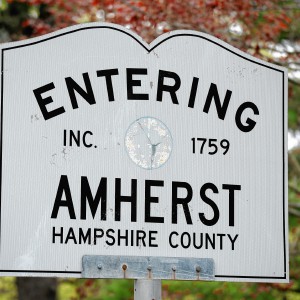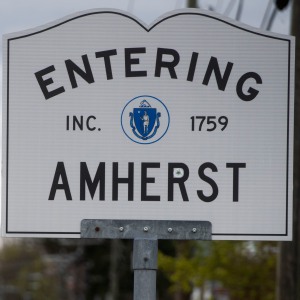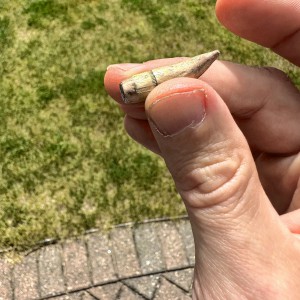Major Manhan dam coming down in Southampton
| Published: 06-01-2022 6:06 PM |
SOUTHAMPTON — Fish will soon be able to swim through a portion of the Manhan River in Southampton that’s been blocked by a dam for nearly 300 years.
Throughout last week, workers from Witch Enterprises of Agawam cut portions of the Lyman Mill Pond Dam in preparation for its complete removal, led by T Ford Co. of Georgetown.
Demolition of the dam will continue over the course of next week.
Removal of the dam is a project seven years in the making, according to Nick Wildman, dam removal practice lead for the state Department of Fish and Game under the Division of Ecological Restoration, which focuses on dam removal in the state. Since 1999, 65 dams have been removed in Massachusetts.
“Removal of this dam reconnects 27 miles of mainstem and tributary streams in the upper part of the Manhan River, which is a lot for dam removal in Massachusetts,” Wildman said. “Most rivers have a dam every few miles, so getting those large reconnections is rare.”
The Lyman Mill Pond Dam is one of two dams being removed this year. The other is in Norwood, a suburb of Boston.
The Southampton dam is built on the foundation of the adjacent former mill building. The building houses Sheldon’s Ice Cream, which is owned by Glenn West of Southampton. West also co-owns Lyman Sheet Metal Co. with his brothers, Kevin West and Keith West, which is located on the other side of the dam.
As the dam deteriorated, West took emergency action by draining the impoundment to reduce pressure on the dam and the mill building.
Article continues after...
Yesterday's Most Read Articles
The Manhan River is a major tributary to the Connecticut River, just south of Northampton. Its main branch is sourced from the Tighe-Carmody Reservoir, which is owned and operated by Holyoke Water Works.
With climate change, West said, storms have gotten bigger and bigger. The higher flow of water from storms has put additional stress on these old structures, Wildman said.
Since West purchased the former mill building in the late 90s, the state’s Office of Dam Safety changed its guidelines in the early 2000s for Massachusetts dam owners, requiring them to have regular inspections, maintenance and repairs.
“I was required to have an inspection done on the dam every three months, with the cost of an engineer coming out of my pocket,” West said.
Each inspection was around $2,000, he said. To adhere to the repairs as assessed in the engineer’s report, West said he would have had to pay $500,000 out of his own pocket.
Of the 3,000 dams in the state, 60% are owned by municipalities.
While Massachusetts has state programs that aid in funding for the repair or removal of city- and town-owned dams, there are few state and federal programs that help private landowners to repair or remove dams, Wildman said.
“While it’s a great start, these programs don’t help private landowners like Glenn. Because these dam removal projects are so technically challenging and costly, no one agency can do it all. It’s always a partnership,” he said.
Funding for the dam removal on the project has been provided by West, the Department of Fish and Game, U.S. Fish & Wildlife Service, Natural Resources Conservation Service, and the Mass Audubon Society.
According to Wildman’s records, the total cost for the dam removal portion of the project is approximately $687,000, which doesn’t include the in-kind hours by all of the partners on the project.
In addition to the cost savings of no longer owning the dam, Wildman said the removal of the dam is a benefit to public safety and the health of the river.
Dams prevent fish migration and limit their ability to escape predation as well as access spawning habitats.
“The biggest concern in the Manhan is the wild brook trout, which is currently a genetic bottleneck … removal will better support the species,” he said.
Another indicator of great water quality is the presence of freshwater mussels. When they reproduce, their babies clip onto fish, so they can better distribute throughout the water body. Without the dam, fish will be able to swim that reconnected 27 miles of river.
“It’ll be a much healthier river … it’s exciting to finally get here to this point after seven years,” West said.
The project has also enabled the relocation of a neighboring resident’s water line, which was running across the bed of the river below the bridge across Route 10.
Although there were initial concerns about whether removing the dam would change the hydraulics of the river that would cause problems with the bridge, which was built in 2005, the water line was able to be safely relocated under the bridge. The relocation work to design, permitting and implementation for the water line came to roughly $759,000 and was paid for by the Division of Ecological Restoration.
The majority of the 3,000 dams in the state have origins in the 1800s and have been added on to, and very few provide any hydropower, Wildman said.
“They’re really just vestiges from the Industrial Revolution,” he said.
The 1854 Lyman Mill was a gristmill, and is part of Southampton’s Lockville Historic District.
The current Lyman Mill Pond Dam was constructed in 1938, according to West. The style is known as an Ambursen dam, which is a buttress dam in which the upstream part is a relatively flat slab made of reinforced concrete.
Before the current dam was built, the Lyman Mill Pond Dam was constructed of stone and originally of wood.
In looking through historical research on the dam, Wildman said there has been a dam in this general area of the Manhan River since about 1732.
To begin the removal process, the spillway of the dam needs to be disconnected from the former mill building, said Jack Enos, president of T Ford Co.
Once the demolition work is complete, workers will rebuild and stabilize the riverbanks.
Enos anticipates that work will be completed around mid-August.
Emily Thurlow can be reached at ethurlow@gazettenet.com.
 Around Amherst: Sustainability Festival camping out on Common Saturday
Around Amherst: Sustainability Festival camping out on Common Saturday Intermittent rail trail closures expected in Amherst, Belchertown
Intermittent rail trail closures expected in Amherst, Belchertown Fearful Belchertown residents blame stray bullets on nearby gun club, appeal to town for help
Fearful Belchertown residents blame stray bullets on nearby gun club, appeal to town for help State: South Hadley’s fiber-optic revenues not public records
State: South Hadley’s fiber-optic revenues not public records 
